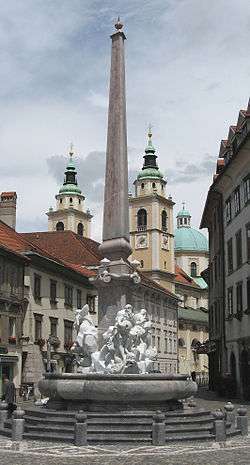Francesco Robba
Francesco Robba (1 May 1698 – 24 January 1757) was an Italian sculptor of the Baroque period. Even though he is regarded as the leading Baroque sculptor of marble statuary in southeastern Central Europe, he has remained practically unknown to international scholars.

Life
Francesco Robba was born in Venice. He received his training in the workshop of the Venetian sculptor Pietro Baratta from 1711 to 1716. In 1720, he moved to Ljubljana to work with the Slovene master Luka Mislej and married his daughter Theresa in 1722.
In this early period, his first marble statues and reliefs still reflect the influence of Pietro Baratta. When Mislej died in 1727, Robba took over his workshop and his clientele. Soon Robba started to earn his own reputation and was awarded commissions by ecclesiastical, aristocratic and bourgeois patrons. Already in 1729 his work was praised in a letter to Prince Emmerich Esterházy, Archbishop of Esztergom by the rector of the Jesuit College in Zagreb, Francesco Saverio Barci.
From 1727 on his works attest of a growing self-confidence. His technical virtuosity manifests itself in the emotional expressions and the refined forms of his statues.
He was recognized by the people of Ljubljana as a "honorary citizen of Ljubljana". In 1743, he was elected to the External Council of the city. In 1745, he was appointed "state engineer" of Carniola. During all this time, he didn't lose contacts with Venice, since he paid several visits to his native city. This allowed him to remain familiar with the Baroque sculpture of central Italy and Rome.
The prevailing view has been that in 1755, Robba left Ljubljana for Zagreb, Croatia, where he died on 24 January 1757.
According to an article published in 2001 by Blaž Resman, an expert in the Baroque, new documents had shown that Robba died in Ljubljana.[1]
Works
_-_relief_sv._Janeza_Nepomuka_na_pro%C4%8Delju_cerkve_sv._Florijana_(F._Robba%2C_1727%2C_marmor).jpg)
The best-known work by Francesco Robba is the Fountain of the Three Rivers of Carniola (1751), representing the Ljubljanica, the Sava and the Krka. It was inspired by the Bernini's Fountain of the Four Rivers on Piazza Navona during Robba's visit to Rome.
Other works include the Narcissus Fountain (Ljubljana), the main altar and the statues (1736) of St. James's Church (Ljubljana), an altar in Ljubljana Cathedral, the majority of the main altar in the Franciscan Church of the Annunciation (Ljubljana), a statue of St. John of Nepomuk in Klagenfurt (Austria) and an altar in the parish church in Vransko.[2] Francesco Robba is also the creator of the main altar of the Ursuline Church of the Holy Trinity in Ljubljana and presumably also of the marble statue of the Holy Trinity Monument that stands in front of it.[3]
The work of Francesco Robba was highlighted in an international scientific symposium, held in Ljubljana in November 1998.
References
- Höfler, Janez (2001). "Epilog k Francescu Robbi". Acta Historiae Artis Slovenica (in Slovenian). Scientific Research Centre, Slovenian Academy of Arts and Sciences. 6. ISSN 1408-0419. Archived from the original on 28 July 2012.
- Slovenian Ministry of Culture register of national heritage reference number ešd 3502
- Jezernik, Božidar (8 July 2011). "Na kaj spominja sv. Trojica na Kongresnem trgu" [What Reminds the Holy Trinity at Congress Square Of?]. Pogledi.si (in Slovenian). Delo, d. d.
Further reading
- Francesco Robba and the Venetian Baroque Sculpture of the Eighteenth Century; Rokus Publishing House Ltd., Ljubljana, Slovenia; ISBN 961-209-160-9
External links
